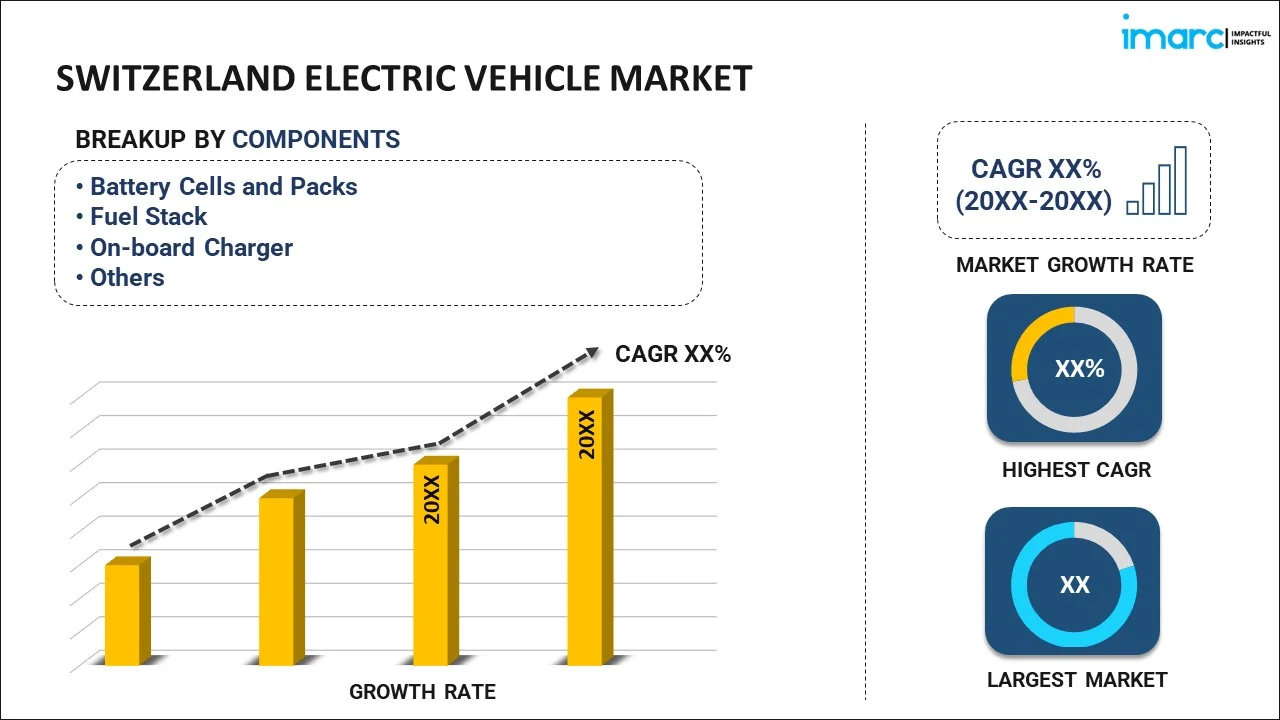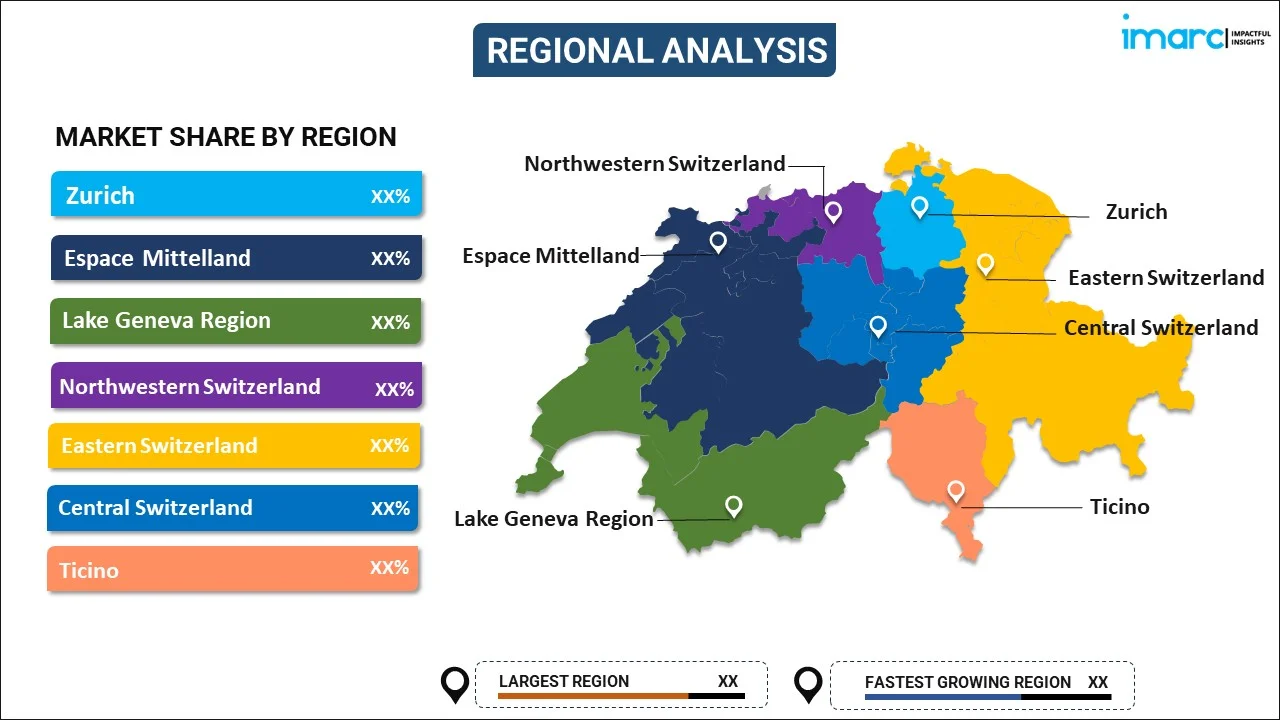
Switzerland Electric Vehicle Market Report by Component (Battery Cells and Packs, Fuel Stack, On-board Charger, Electric Motor, Brake, Wheel and Suspension, Body and Chassis, and Others), Propulsion Type (Battery Electric Vehicle (BEV), Fuel Cell Electric Vehicle (FCEV), Plug-In Hybrid Electric Vehicle (PHEV)), Vehicle Type (Passenger Vehicles, Commercial Vehicles, and Others), and Region 2024-2032
Switzerland Electric Vehicle Market Overview:
The Switzerland electric vehicle market size is projected to exhibit a growth rate (CAGR) of 17.50% during 2024-2032. The rising government incentives, stringent emission regulations, high environmental awareness, advanced charging infrastructure, increasing fuel prices, technological advancements in EV batteries, and steadily expanding automotive industry are some of the major factors propelling the growth of the market.
|
Report Attribute
|
Key Statistics
|
|---|---|
|
Base Year
|
2023 |
|
Forecast Years
|
2024-2032
|
|
Historical Years
|
2018-2023
|
| Market Growth Rate (2024-2032) | 17.50% |
Switzerland Electric Vehicle Market Trends:
Advanced Charging Infrastructure
The increasing investment in developing a robust network of charging stations across the country is driving the growth of the market. This extensive infrastructure reduces range anxiety and makes owning an electric vehicle more convenient, thereby encouraging more consumers to switch to electric mobility. The availability of widespread charging facilities enhances consumer confidence in the practicality and reliability of electric vehicles. For instance, in January 2024, Domestic electric vehicle ride-hailing and charging infrastructure platform BluSmart announced that Switzerland-based responsAbility Investments AG will invest up to $25 million (Rs 208 crore) in the company. In a statement, the company said that the investment will help BluSmart expand its EV charging infrastructure across the country. It also had secured $24 million in an equity round while raising long-term and sustainable EV asset financing of $200 million, backed by leading development financial institutions. As a part of its broader $500 million climate investment strategy, responsAbility on behalf of its investors declared that it will invest up to $25 million in BluSmart.
Government Incentives and Stringent Emission Regulations
The Swiss government offers substantial subsidies, tax breaks, and rebates to promote electric vehicle adoption which is contributing to the growth of the market. Stringent CO2 emission standards compel manufacturers and consumers to opt for eco-friendly alternatives, significantly boosting the EV market. For instance, in 2022, the federal government waived the 4% automobile import tax for new electric vehicles. This tax benefit could be challenged in the coming years. At regional and local levels, some cantons and municipalities propose tax incentives or even subsidies to alternative energy vehicles and charging infrastructure. For vehicles, these subsidies are often modest, with support for hybrid electric vehicles being gradually phased out. Grants are increasingly focused on recharging infrastructure, especially the basic equipment needed for the later deployment of charging stations. The federal and cantonal governments are also working to remove barriers to the planning, installation, and operation of charging stations.
Switzerland Electric Vehicle Market News:
In February 2024, BYD, the world's leading manufacturer of new energy vehicles and power hbatteries, and the Emil Frey Group agreed on a partnership to distribute and sell BYD’s range of innovative electric vehicles in Switzerland and Liechtenstein. This partnership represents a significant milestone for both BYD and Emil Frey. It heralds the dawn of a new era of cutting-edge electric vehicles in the Swiss and Liechtenstein automotive markets.
In August 2023, Energy Infrastructure Partners, a leading investor in the energy transition, signed an agreement on behalf of a group of Swiss pension funds it represents, to partner with Electra, an early mover and European champion in the electric vehicle infrastructure industry. As portfolio manager for an investment group of Swiss pension funds focused on Swiss energy infrastructure within the Credit Suisse Investment Foundation, EIP will manage a 49.9% share of the new joint venture with EUR 200 million in initial capital to be injected through 2026. The joint venture’s mission is to expand Electra’s installed base of charging sites in the Swiss and Austrian markets.
Switzerland Electric Vehicle Market Segmentation:
IMARC Group provides an analysis of the key trends in each segment of the market, along with forecasts at the country level for 2024-2032. Our report has categorized the market based on component, propulsion type and vehicle type.
Component Insights:

- Battery Cells and Packs
- Fuel Stack
- On-Board Charger
- Electric Motor
- Brake, Wheel and Suspension
- Body and Chassis
- Others
The report has provided a detailed breakup and analysis of the market based on the component. This includes battery cells and packs, fuel stack, on-board charger, electric motor, brake, wheel and suspension, body and chassis, and others.
Propulsion Type Insights:
- Battery Electric Vehicle (BEV)
- Fuel Cell Electric Vehicle (FCEV)
- Plug-In Hybrid Electric Vehicle (PHEV)
A detailed breakup and analysis of the market based on the propulsion type have also been provided in the report. This includes battery electric vehicle (BEV), fuel cell electric vehicle (FCEV) and plug-in hybrid electric vehicle (PHEV).
Vehicle Type Insights:
- Passenger Vehicles
- Commercial Vehicles
- Others
A detailed breakup and analysis of the market based on the vehicle type have also been provided in the report. This includes passenger vehicles, commercial vehicles, and others.
Regional Insights:

- Zurich
- Espace Mittelland
- Lake Geneva Region
- Northwestern Switzerland
- Eastern Switzerland
- Central Switzerland
- Ticino
The report has also provided a comprehensive analysis of all the major regional markets, which include Zurich, Espace Mittelland, Lake Geneva Region, Northwestern Switzerland, Eastern Switzerland, Central Switzerland, and Ticino.
Competitive Landscape:
The market research report has also provided a comprehensive analysis of the competitive landscape in the market. Competitive analysis such as market structure, key player positioning, top winning strategies, competitive dashboard, and company evaluation quadrant has been covered in the report. Also, detailed profiles of all major companies have been provided.
Switzerland Electric Vehicle Market Report Coverage:
| Report Features | Details |
|---|---|
| Base Year of the Analysis | 2023 |
| Historical Period | 2018-2023 |
| Forecast Period | 2024-2032 |
| Units | Million Units |
| Scope of the Report | Exploration of Historical Trends and Market Outlook, Industry Catalysts and Challenges, Segment-Wise Historical and Future Market Assessment:
|
| Components Covered | Battery Cells and Packs, Fuel Stack, On-board Charger, Electric Motor, Brake, Wheel and Suspension, Body and Chassis, Others |
| Propulsion Types Covered | Battery Electric Vehicle (BEV), Fuel Cell Electric Vehicle (FCEV), Plug-In Hybrid Electric Vehicle (PHEV) |
| Vehicle Types Covered | Passenger Vehicles, Commercial Vehicles, Others |
| Regions Covered | Zurich, Espace Mittelland, Lake Geneva Region, Northwestern Switzerland, Eastern Switzerland, Central Switzerland, Ticino |
| Customization Scope | 10% Free Customization |
| Post-Sale Analyst Support | 10-12 Weeks |
| Delivery Format | PDF and Excel through Email (We can also provide the editable version of the report in PPT/Word format on special request) |
Key Questions Answered in This Report:
- How has the Switzerland electric vehicle market performed so far and how will it perform in the coming years?
- What has been the impact of COVID-19 on the Switzerland electric vehicle market?
- What is the breakup of the Switzerland electric vehicle market on the basis of component?
- What is the breakup of the Switzerland electric vehicle market on the basis of propulsion type?
- What is the breakup of the Switzerland electric vehicle market on the basis of vehicle type?
- What are the various stages in the value chain of the Switzerland electric vehicle market?
- What are the key driving factors and challenges in the Switzerland electric vehicle?
- What is the structure of the Switzerland electric vehicle market and who are the key players?
- What is the degree of competition in the Switzerland electric vehicle market?
Key Benefits for Stakeholders:
- IMARC’s industry report offers a comprehensive quantitative analysis of various market segments, historical and current market trends, market forecasts, and dynamics of the Switzerland electric vehicle market from 2018-2032.
- The research report provides the latest information on the market drivers, challenges, and opportunities in the Switzerland electric vehicle market.
- Porter's five forces analysis assist stakeholders in assessing the impact of new entrants, competitive rivalry, supplier power, buyer power, and the threat of substitution. It helps stakeholders to analyze the level of competition within the Switzerland electric vehicle industry and its attractiveness.
- Competitive landscape allows stakeholders to understand their competitive environment and provides an insight into the current positions of key players in the market.
Need more help?
- Speak to our experienced analysts for insights on the current market scenarios.
- Include additional segments and countries to customize the report as per your requirement.
- Gain an unparalleled competitive advantage in your domain by understanding how to utilize the report and positively impacting your operations and revenue.
- For further assistance, please connect with our analysts.
 Inquire Before Buying
Inquire Before Buying
 Speak to an Analyst
Speak to an Analyst
 Request Brochure
Request Brochure
 Request Customization
Request Customization




.webp)




.webp)












